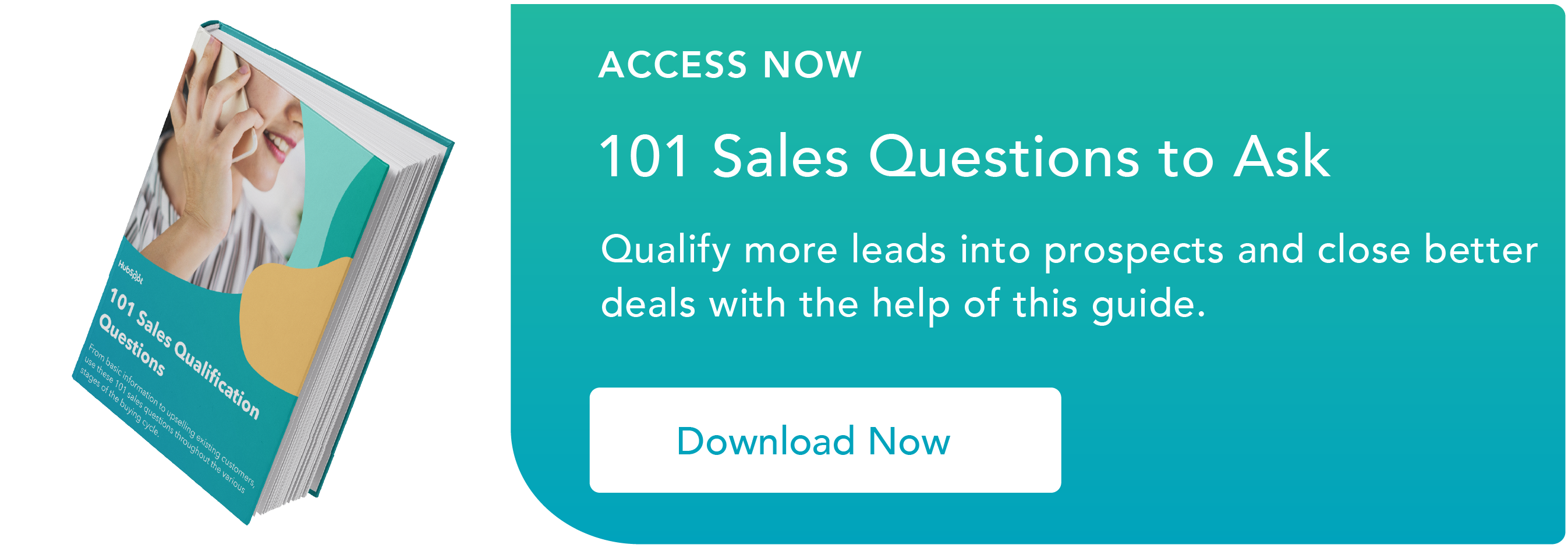But the contrast between persistence and pushiness isn't always so clear. If you're doing any of the things on the list below, you might be coming off as pushy without even realizing it.
1. Never call or email without new updates to share.
What you think: You're keeping yourself top-of-mind and on your prospect's radar.
Why it's pushy: You're keeping yourself top-of-mind, all right -- as that annoying salesperson who won't stop calling. Don't reach out unless you have something new to share; otherwise you're taking up your prospect's time without providing any value.
2. Always ask a different question.
What you think: You haven't gotten the information you need, so it can't hurt to ask again ... right?
Why it's pushy: Your prospect has already answered your question to the best of their ability, so why keep beating a dead horse? Try phrasing your question a different way or coming at it from a different angle to avoid exhausting your prospects.
3. Avoid talking about your product right away.
What you think: Your product is great! Why wouldn't a prospect want to hear about it?
Why it's pushy: Never lead by talking about your product. Unless your prospect is already quite familiar with your product's value proposition, starting with the value it brings and how it will change your prospect's business is a more effective way to get a conversation started.
4. Skip declarative words and phrases ("should," "have to," "need to," etc.)
What you think: You try to spend time during each sales call giving advice and sharing best practices with your prospects.
Why it's pushy: Your intentions are noble, so keep doing what you're doing. The problem here is a matter of semantics. Telling a prospect repeatedly what they "should" or "have to" or "need to" do comes off as bossy and condescending even if your only intent is to help. Instead, try phrases like, "Businesses like yours have seen success …" or "What we've found drives results is …"
5. Ask questions instead of making statements.
What you think: You're an expert on the vertical you sell into, so there are a few safe assumptions you can make about your prospect's business.
Why it's pushy: While your prospect's business might function like the hundreds you've seen before in their industry, you don't necessarily know the specifics. Even if you have a pretty good sense of what the answer might be, asking questions such as, "So I've seen X problem a lot at companies like yours, are you experiencing something similar?" shows your prospect that you care about their unique perspective, while simultaneously showing off your expertise.
6. Don't answer objections with "But … "
What you think: You're just trying to handle objections, and "but" is the first filler word that comes to mind.
Why it's pushy: Constantly saying "but" comes off as argumentative and puts prospects on the defensive. Instead, try the Ransberger Pivot:
- Acknowledge your prospect's objections.
- Understand their hesitation, or ask questions until you do.
- Find a common goal burned in your prospect's objections, and build on it to convince them your offering is the best way to achieve that end.
7. Treat all objections as unique.
What you think: You (understandably) want to make the sale, so sometimes you find yourself on autopilot when answering objections.
Why it's pushy: There's a significant difference between, "This problem is a priority for us, but let's wait until next quarter to talk … " and "We've had seven straight quarters of losses -- we just can't afford to implement anything right now."
Not all objections are created equal. Some can be resolved simply by educating your prospect. Some are a result of inertia and can be mitigated by creating a sense of urgency. But there are always objections that stop a deal in its tracks, and treating those like minor concerns that can be talked away won't endear you to your prospects. Learn to spot the difference between brush-offs, points of confusion, and true blockers.
8. Let your prospect off the phone.
What you think: Your prospect actually picked up! You've got to take advantage of the opportunity and cover as much as possible.
Why it's pushy: Your prospect is busy. Really busy. If they're a good fit for your product, schedule a longer call when they have more time and follow up with helpful resources so you stay on their radar.
9. Never force the offering.
What you think: You're trying to pique your prospect's interest by mentioning new product lines or services that could benefit them.
Why it's pushy: Offering an add-on or trying to go for an upsell isn't inherently bad. Just be sure you're telling a coherent story that ties all your offerings together. Making it clear that you're tailoring a specific set of products for your prospect avoids the impression that you're throwing everything at the wall to see what sticks.
10. Know when to say when.
What you think: If you just try a little harder, maybe your prospect will buy.
Why it's pushy: It's unfortunate, but let's face it -- you won't win every deal. At some point in most closed-lost deals, it becomes apparent that there's no more you can do, and continuing to pester a prospect will leave a bad taste in their mouths. So know when to throw in the towel. Your time is better spent on prospects who stand a good chance of closing.
11. Get buy-in from your prospect.
What you think: You've gone through this sales process hundreds of times before, and you know what makes sense for your buyers.
Why it's pushy: Besides the fact that it's just not smart to try and run a sales process without confirming your prospect is okay with it, it's also bad manners. At every step of the way, check to see whether your proposed next steps make sense. Not only will your prospect appreciate your solicitousness, getting their buy-in on small steps will psychologically make it easier for them to say "yes" to the big ask -- would you like to buy?
12. Speak slowly and allow your prospect to respond.
What you think: You're naturally a fast talker and an enthusiastic person.
Why it's pushy: You're understandably excited about your product and eager to share its value with prospects. But blazing through a conversation creates the impression that you're just waiting until your prospect's done speaking so you can talk again. Cutting prospects off is a no-no as well -- in fact, the less you speak, the more useful information you're likely to get.
13. Align your calls-to-action with your prospect's buying stage.
What you think: You can tell your buyer has the business pain your product solves, and you want to help them by jumping into a formal sales process.
Why it's pushy: Just because you can tell a buyer suffers from X business pain doesn't mean they've realized it yet. So even if a call-to-action will eventually be useful for them (like a product demo), offering it when they're still in the education stage just makes it seem like you're rushing them along because you want to close a deal. Instead, move the sales process forward by teaching your buyers about their problems and helping them devise a solution that includes your product if appropriate.
14. Take no for an answer.
What you think: You know certain commitments make prospects far likelier to close, so if at first you don't succeed in getting the buyer's phone number, an introduction to the signing authority, or a meeting with Procurement, you keep trying.
Why it's pushy: Your prospect has rejected your request for a reason. They don't feel comfortable giving you the information or help you've requested, and asking again will only make them more uncomfortable.
The issue probably stems from how and when you asked. If you haven't explained why your ask will benefit your prospect and timed it appropriately, of course they'll say no. It's fine to ask for their personal number on the first call (provided you give context, such as, "It'll make it easier to answer questions and schedule future meetings if we have each other's cells.") However, it's typically not a good idea to ask for an intro to the decision maker -- you haven't yet proven your value.
15. Vary your outreach.
What you think: You have the buyer's email address, so when you're trying to connect with them or engage them after they've gone dark, you keep sending emails.
Why it's pushy: It's the "boy who cried wolf" effect. After a while, your buyer will completely tune out your messages. The same holds true no matter which channel you're using -- if you keep calling them or nudging them on social media, you'll quickly become a nuisance.
To avoid this issue, spread your outreach across multiple mediums. Here's a sample schedule:
- Day 1: Email.
- Day 3: Call (leave a voicemail.)
- Day 4: Like their post on LinkedIn.
- Day 6: Call (don't leave a voicemail.)
- Day 8: Email.
- Day 10: Send a break-up email.
Simply mixing up your outreach decreases the chances you'll seem stalkerish.
The behavior that comes off as pushy to buyers likely sparks from your excitement to share insights with your prospects and help as many as possible. This isn't a bad attitude to have. But realize that you won't get through to prospects who are frustrated with yet another "pushy" salesperson. Avoid these bad habits so you never lose a deal for the wrong reasons.
Sales Communication




![Active Listening Techniques To Use On Your Next Sales Call [+ Examples]](https://53.fs1.hubspotusercontent-na1.net/hubfs/53/active-listening-1-20250218-4164086.webp)
![How to Reply to a Sales Rejection Email From a Client [+ Templates]](https://53.fs1.hubspotusercontent-na1.net/hubfs/53/timing-objection-responses-1.jpg)




%20(1).png)

